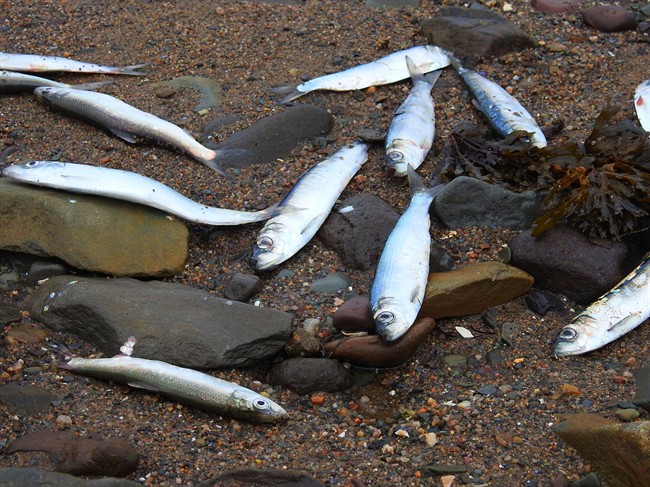Tens of thousands of dead herring keep washing ashore along Nova Scotia’s western coastline, a mystery for biologists trying to figure out what is killing the small, silvery fish.

The first sightings were reported two weeks ago at beaches along the eastern edge of St. Marys Bay, which separates the sliver of land known as Digby Neck from the Nova Scotia mainland.
Since then, several reports of dead and dying herring have come in from different parts of the bay, and now dead herring are showing up farther to the east in the Annapolis Basin and near Bear River.
Biology professor Shawn Craik said local fishermen can’t recall seeing herring wash up on the beaches in such large numbers.
Craik said he was inspecting a beach with students last Friday when he spoke with an old clam fisherman who was standing among a pile of 50 or so herring.
“He was bewildered,” said Craik, an ornithologist at Sainte-Anne University in western Nova Scotia.

Get breaking National news
Craik said the fish could be succumbing to a virus, some form of pollution, parasites or a poisonous algae bloom — but lab tests have yet to determine what is going on.
“If there was a toxin getting into these fish and being passed on the scavengers, you would expect that someone, somewhere would find some dead gulls,” he said, adding that no such reports have come in.
- Loonie’s plunge just one consequence of Trump tariff threat on your wallet
- Canada Post says it missed delivering nearly 10M parcels amid strike
- N.S. election: Results could be delayed after voting station opens late near Halifax
- Will Canada’s tax ‘holiday’ create a ‘mess’ for businesses? Some say yes
A spokesman for the federal Fisheries Department in Digby said test results from a laboratory in Moncton, N.B., should be available by Friday or early next week. Tests are also being conducted at the Atlantic Veterinary College in Charlottetown.
Herring are known as a forage fish, which means their large schools play an important roll in feeding whales, seabirds, seals and larger fish, such as cod.
In August, a report from the World Wildlife Fund concluded that Canadian forage fish are in trouble. The conservation group looked at 27 fisheries and found that three fisheries in Atlantic Canada are in critical condition, including two herring stocks in the Gulf of St. Lawrence.
The report said that in all cases, fisheries management does not sufficiently account for predator needs.
There has been speculation that the number of dead herring in Nova Scotia is much higher than originally thought because many others would have disappeared beneath the waves or be eaten by crows and gulls. And with so many fish left on the rocky beaches, it would appear that the scavengers have had their fill.
“They’re being left untouched,” said Craik. “That suggests that there’s probably a overabundance of these fish that are available.”
Craik said he received another report of dead fish early Thursday from Smiths Cove, which is near Digby, N.S.
Earlier reports suggested the fish could have been driven ashore by predators.
“I would go for ruling that out now, given the scope of the problem,” he said. “But it’s still very much up in the air.”







Comments